Mineral Composition of Prospective Section of Wufeng-Longmaxi Shale in Luzhou Shale Play, Sichuan Basin
Abstract
:1. Introduction
2. Geological Setting
3. Samples and Methods
4. Results
5. Discussion
5.1. Comparison of Mineral Composition of Sublayers between Wells
5.2. Relationship between Mineral Content and Other Geological Parameters
5.3. Evaluation of Mineral Composition of Each Sublayer
6. Conclusions
- (1)
- The content of quartz, which was the dominant mineral type in the L11-WF zone of the Luzhou shale play, ranged from 16.9% to 87.21% (average 51.33%). The subordinate mineral was illite, with content of 1.49–51.5% (average of 17.76%). The averages for calcite, dolomite, and pyrite were 7.88%, 5.60%, and 3.24%, respectively.
- (2)
- In the northern part of the study area, as depth increased in the northwest-to-southeast direction; there was a relative increase in the siliceous minerals and relative decrease in the clay minerals within the same sublayers. However, in the northeast-to-southwest direction, there was no obvious link between the mineral content within the same sublayers and the changing depth.
- (3)
- Quartz content and TOC showed a moderately positive correlation, which indicated that quartz found in this region was of biological origin; the sum content of siliceous minerals and carbonaceous minerals was positively correlated to BRIT in a moderate degree, respectively, in well SS1H2-7 and in the well group of RS8 and RS5, which indicated that, in general, siliceous minerals and carbonaceous minerals had a relatively active effect on reservoir compressibility.
- (4)
- Based on the mineralogical characteristics of the sublayers, reservoir types can be identified as the following four: Type I reservoirs had high brittleness and low plasticity, which are conducive to natural and artificial fracturing, and included the vast majority of L113, L112, and L111 samples, most of the WF samples, and a small number of the L114 samples. Type II is reservoirs were dominated by carbonate minerals, most of which were limestone strata in the Guanyinqiao member; the Type II reservoirs had less compressibility than the Type I reservoirs. Type III reservoirs had moderate brittleness and moderate compressibility. The L114 sublayer samples were mostly of this type. Type IV, which had low brittleness and high plasticity, also included a small number of WF samples. Reservoirs of this type portrayed low compressibility, known to hinder the development of hydraulic fracturing.
- (5)
- In the future, the origin of minerals, and the influence of mineral composition on rock mechanical parameters need to be further discussed.
Author Contributions
Funding
Data Availability Statement
Conflicts of Interest
References
- Zou, C.; Zhao, Q.; Cong, L.; Wang, H.; Shi, Z.; Wu, J.; Pan, S. Development progress, potential and prospect of shale gas in China. Nat. Gas Ind. 2021, 41, 1–14. [Google Scholar] [CrossRef]
- Jiang, T.; Bian, X.; Wang, H.; Li, S.; Jia, C.; Liu, H.; Sun, H. Volume fracturing of deep shale gas horizontal wells. Nat. Gas Ind. B 2017, 4, 127–133. [Google Scholar] [CrossRef]
- Liang, X.; Wang, L.; Zhang, J.; Xian, C.; Wang, G.; Zhao, C. 100% in the sweet section: An effective geosteering approach for silurian longmaxi shale play in Sichuan Basin. In Proceedings of the Society of Petroleum Engineers—SPE Asia Pacific Unconventional Resources Conference and Exhibition, Brisbane, QLD, Australia, 9–11 November 2015. [Google Scholar]
- Liu, J.; Yao, Y.; Liu, D.; Pan, Z.; Cai, Y. Comparison of three key marine shale reservoirs in the southeastern margin of the sichuan basin, SW china. Minerals 2017, 7, 179. [Google Scholar] [CrossRef] [Green Version]
- Li, H.; Tang, H.; Zheng, M. Micropore structural heterogeneity of siliceous shale reservoir of the longmaxi formation in the southern Sichuan basin, China. Minerals 2019, 9, 548. [Google Scholar] [CrossRef] [Green Version]
- Wang, X.; Jiang, Z.; Jiang, S.; Chang, J.; Zhu, L.; Li, X.; Li, J. Full-scale pore structure and fractal dimension of the Longmaxi shale from the southern Sichuan basin: Investigations using FE-SEM, gas adsorption and mercury intrusion porosimetry. Minerals 2019, 9, 543. [Google Scholar] [CrossRef] [Green Version]
- Xiong, J.; Liu, K.; Shi, C.; Liu, X.; Huang, L. Logging prediction and evaluation of fracture toughness for the shales in the Longmaxi Formation, Southern Sichuan Basin. Petroleum 2020, 7, 254–262. [Google Scholar] [CrossRef]
- Xu, Z.; Zheng, M.; Liu, Z.; Deng, J.; Li, X.; Guo, W.; Li, J.; Wang, N.; Zhang, X.; Guo, X. Petrophysical properties of deep Longmaxi Formation shales in the southern Sichuan Basin, SW China. Pet. Explor. Dev. 2020, 47, 1183–1193. [Google Scholar] [CrossRef]
- Ye, Y.; Tang, S.; Xi, Z. Brittleness evaluation in shale gas reservoirs and its influence on fracability. Energies 2020, 13, 388. [Google Scholar] [CrossRef] [Green Version]
- Dai, J.; Zou, C.; Dong, D.; Ni, Y.; Wu, W.; Gong, D.; Wang, Y.; Huang, S.; Huang, J.; Fang, C.; et al. Geochemical characteristics of marine and terrestrial shale gas in China. Mar. Pet. Geol. 2016, 76, 444–463. [Google Scholar] [CrossRef]
- Hu, H.; Hao, F.; Guo, X.; Yi, J.; Shu, Z.; Bao, H.; Zhu, X. Effect of lithofacies on the pore system of over-mature Longmaxi shale in the Jiaoshiba area, Sichuan Basin, China. Mar. Pet. Geol. 2019, 109, 886–898. [Google Scholar] [CrossRef]
- Wang, Z.; Chen, L.; Chen, D.; Lai, J.; Deng, G.; Liu, Z.; Wang, C. Characterization and evaluation of shale lithofacies within the lowermost Longmaxi-Wufeng Formation in the Southeast Sichuan Basin. J. Pet. Sci. Eng. 2020, 193, 107353. [Google Scholar] [CrossRef]
- Nie, H.; He, Z.; Liu, G.; Du, W.; Wang, R.; Zhang, G. Genetic mechanism of high-quality shale gas reservoirs in the Wufeng–LongmaxiFms in the Sichuan Basin. Nat. Gas Ind. B 2021, 8, 24–34. [Google Scholar] [CrossRef]
- Chen, S.; Zhu, Y.; Qin, Y.; Wang, H.; Liu, H.; Fang, J. Reservoir evaluation of the Lower Silurian Longmaxi Formation shale gas in the southern Sichuan Basin of China. Mar. Pet. Geol. 2014, 57, 619–630. [Google Scholar] [CrossRef]
- Jiang, Z.; Song, Y.; Tang, X.; Li, Z.; Wang, X.; Wang, G.; Xue, Z.; Li, X.; Zhang, K.; Chang, J.; et al. Controlling factors of marine shale gas differential enrichment in southern China. Pet. Explor. Dev. 2020, 47, 661–673. [Google Scholar] [CrossRef]
- Li, X.; Zhang, J.; Wang, Y.; Zhao, P.; Wang, Z.; Xu, H.; Wang, G.; Wang, F. Accumulation conditions of Lower Paleozoic shale gas from the southern Sichuan Basin, China. J. Nat. Gas Geosci. 2016, 1, 101–108. [Google Scholar] [CrossRef] [Green Version]
- Zhao, J.; Jin, Z.; Hu, Q.; Liu, K.; Jin, Z.; Hu, Z.; Nie, H.; Du, W.; Yan, C.; Wang, R. Mineral composition and seal condition implicated in pore structure development of organic-rich Longmaxi shales, Sichuan Basin, China. Mar. Pet. Geol. 2018, 98, 507–522. [Google Scholar] [CrossRef]
- Wu, J.; Yuan, Y.; Niu, S.; Wei, X.; Yang, J. Multiscale characterization of pore structure and connectivity of Wufeng-Longmaxi shale in Sichuan Basin, China. Mar. Pet. Geol. 2020, 120, 104514. [Google Scholar] [CrossRef]
- Wu, J.; Liang, C.; Yang, R.; Xie, J. The significance of organic matter–mineral associations in different lithofacies in the Wufeng and longmaxi shale-gas reservoirs in the Sichuan Basin. Mar. Pet. Geol. 2021, 126, 104866. [Google Scholar] [CrossRef]
- Xu, H.; Zhou, W.; Zhang, R.; Liu, S.; Zhou, Q. Characterizations of pore, mineral and petrographic properties of marine shale using multiple techniques and their implications on gas storage capability for Sichuan Longmaxi gas shale field in China. Fuel 2019, 241, 360–371. [Google Scholar] [CrossRef]
- Jiang, W.; Cao, G.; Luo, C.; Lin, M.; Ji, L.; Zhou, J. A composition-based model for methane adsorption of overmature shales in Wufeng and Longmaxi Formation, Sichuan Basin. Chem. Eng. J. 2022, 429, 130766. [Google Scholar] [CrossRef]
- Wang, G.; Jin, Z.; Liu, G.; Liu, Q.; Liu, Z.; Wang, H.; Liang, X.; Jiang, T.; Wang, R. Geological implications of gamma ray (GR) anomalies in marine shales: A case study of the Ordovician-Silurian Wufeng-Longmaxi succession in the Sichuan Basin and its periphery, Southwest China. J. Asian Earth Sci. 2020, 199, 104359. [Google Scholar] [CrossRef]
- Gou, Q.; Xu, S.; Hao, F.; Zhang, B.; Shu, Z.; Yang, F.; Wang, Y.; Li, Q. Quantitative calculated shale gas contents with different lithofacies: A case study of Fuling gas shale, Sichuan Basin, China. J. Nat. Gas Sci. Eng. 2020, 76, 103222. [Google Scholar] [CrossRef]
- Kang, Y.; Shang, C.; Zhou, H.; Huang, Y.; Zhao, Q.; Deng, Z.; Wang, H.; Ma, Y.Z. Mineralogical brittleness index as a function of weighting brittle minerals—From laboratory tests to case study. J. Nat. Gas Sci. Eng. 2020, 77, 103278. [Google Scholar] [CrossRef]
- Zhang, B.; Shan, B.; Zhao, Y.; Zhang, L. Review of formation and gas characteristics in shale gas reservoirs. Energies 2020, 13, 5427. [Google Scholar] [CrossRef]
- Hua, G.; Wu, S.; Jing, Z.; Yu, X.; Xu, K.; Shi, W.; Guan, M. Rock physical and chemical alterations during the in-situ interaction between fracturing fluid and Silurian organic-rich shales in China. J. Nat. Gas Sci. Eng. 2021, 94, 104075. [Google Scholar] [CrossRef]
- Levinthal, J.D.; Richards, B.; Snow, M.S.; Watrous, M.G.; McDonald, L.W. Correlating NORM with the mineralogical composition of shale at the microstructural and bulk scale. Appl. Geochem. 2017, 76, 210–217. [Google Scholar] [CrossRef]
- Iqbal, M.A.; Rezaee, R.; Smith, G.; Ekundayo, J.M. Shale lithofacies controls on porosity and pore structure: An example from Ordovician Goldwyer Formation, Canning Basin, Western Australia. J. Nat. Gas Sci. Eng. 2021, 89, 103888. [Google Scholar] [CrossRef]
- He, J.; Li, X.; Yin, C.; Zhang, Y.; Lin, C. Propagation and characterization of the micro cracks induced by hydraulic fracturing in shale. Energy 2020, 191, 116449. [Google Scholar] [CrossRef]
- Zhao, G.; Ding, W.; Sun, Y.; Wang, X.; Tian, L.; Liu, J.; Shi, S.; Jiao, B.; Cui, L. Fracture development characteristics and controlling factors for reservoirs in the Lower Silurian Longmaxi Formation marine shale of the Sangzhi block, Hunan Province, China. J. Pet. Sci. Eng. 2020, 184, 106470. [Google Scholar] [CrossRef]
- Du, J.; Whittle, A.J.; Hu, L.; Divoux, T.; Meegoda, J.N. Characterization of meso-scale mechanical properties of Longmaxi shale using grid microindentation experiments. J. Rock Mech. Geotech. Eng. 2021, 13, 555–567. [Google Scholar] [CrossRef]
- Li, G.; Li, G.; Wang, Y.; Qi, S.; Yang, J. A rock physics model for estimating elastic properties of upper Ordovician-lower Silurian mudrocks in the Sichuan Basin, China. Eng. Geol. 2020, 266, 105460. [Google Scholar] [CrossRef]
- Ma, Y.; Ardakani, O.H.; Zhong, N.; Liu, H.; Huang, H.; Larter, S.; Zhang, C. Possible pore structure deformation effects on the shale gas enrichment: An example from the Lower Cambrian shales of the Eastern Upper Yangtze Platform, South China. Int. J. Coal Geol. 2020, 217, 103349. [Google Scholar] [CrossRef]
- Zhang, L.; Xiao, D.; Lu, S.; Jiang, S.; Chen, L.; Guo, T.; Wu, L. Pore development of the Lower Longmaxi shale in the southeastern Sichuan Basin and its adjacent areas: Insights from lithofacies identification and organic matter. Mar. Pet. Geol. 2020, 122, 104662. [Google Scholar] [CrossRef]
- Chen, J.; Lan, H.; Macciotta, R.; Martin, C.D.; Wu, Y. Microfracture characterization of shale constrained by mineralogy and bedding. J. Pet. Sci. Eng. 2021, 201, 108456. [Google Scholar] [CrossRef]
- Jiarui, Z.; Jianting, X.; Shengming, J.; Shuai, T. Quantitative identification and distribution of quartz genetic types based on QemScan: A case study of Silurian Longmaxi Formation in Weiyuan area, Sichuan Basin. Pet. Res. 2021. [Google Scholar] [CrossRef]
- Roshani, M.; Sattari, M.A.; Muhammad Ali, P.J.; Roshani, G.H.; Nazemi, B.; Corniani, E.; Nazemi, E. Application of GMDH neural network technique to improve measuring precision of a simplified photon attenuation based two-phase flowmeter. Flow Meas. Instrum. 2020, 75, 101804. [Google Scholar] [CrossRef]
- Yang, H.; Zhao, S.; Liu, Y.; Wu, W.; Xia, Z.; Wu, T.; Luo, C.; Fan, T.; Yu, L. Main controlling factors of enrichment and high-yield of deep shale gas in the Luzhou Block, southern Sichuan Basin. Nat. Gas Ind. 2019, 39, 55–63. [Google Scholar] [CrossRef]
- Patzschke, M. Advanced Microanalysis with The QUANTAX System. Available online: https://www.bruker.com/en/news-and-events/webinars/2019/analytical-sem-solutions-for-geology-part-i.html (accessed on 22 November 2021).
- Gamero-Diaz, H.; Miller, C.; Lewis, R. sCore: A mineralogy based classification scheme for organic mudstones. In Proceedings of the Society of Petroleum Engineers—SPE Annual Technical Conference and Exhibition; OnePetro: Moscow, Russia, 2013; Volume 3, pp. 2465–2481. [Google Scholar]
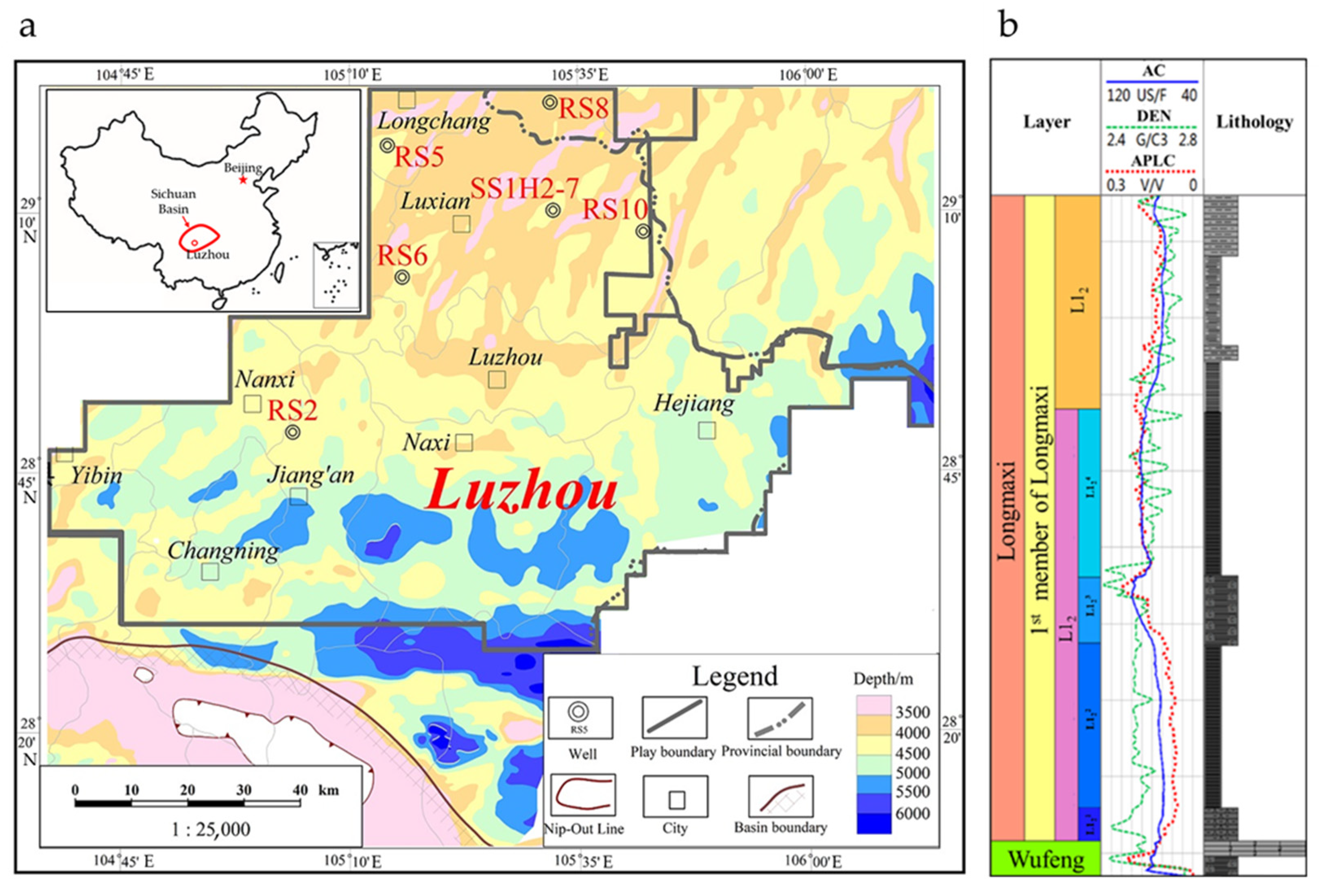
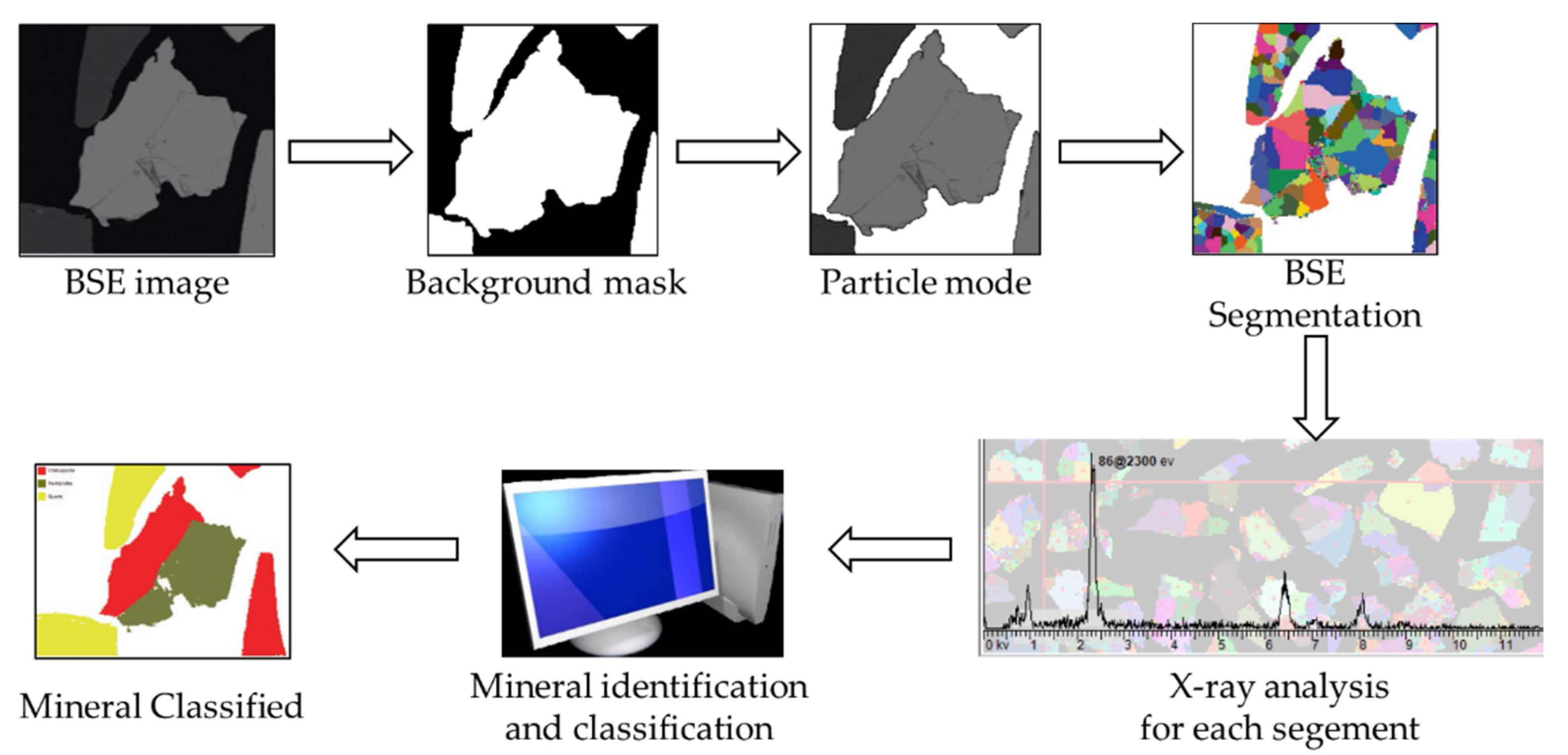

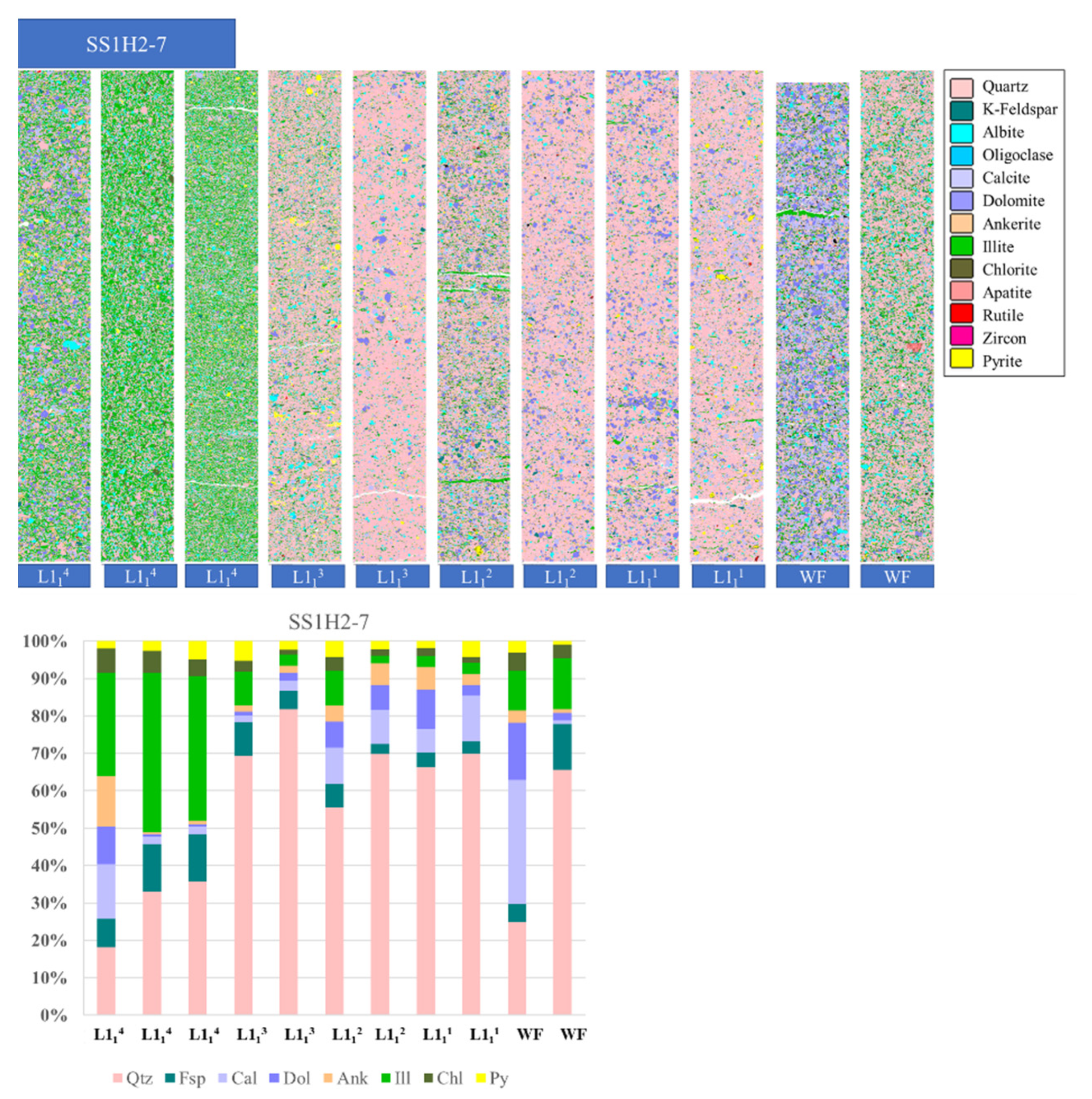
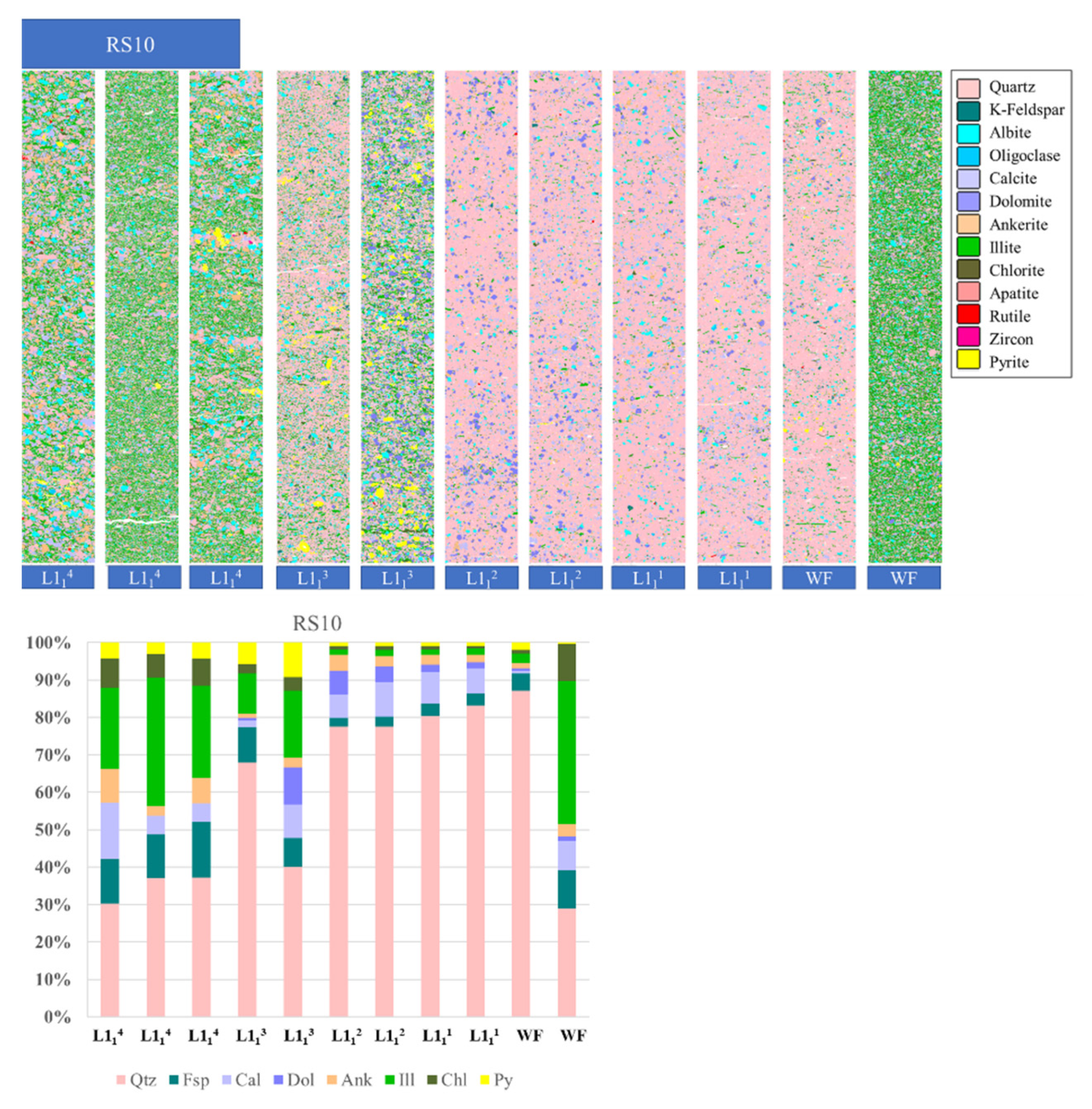
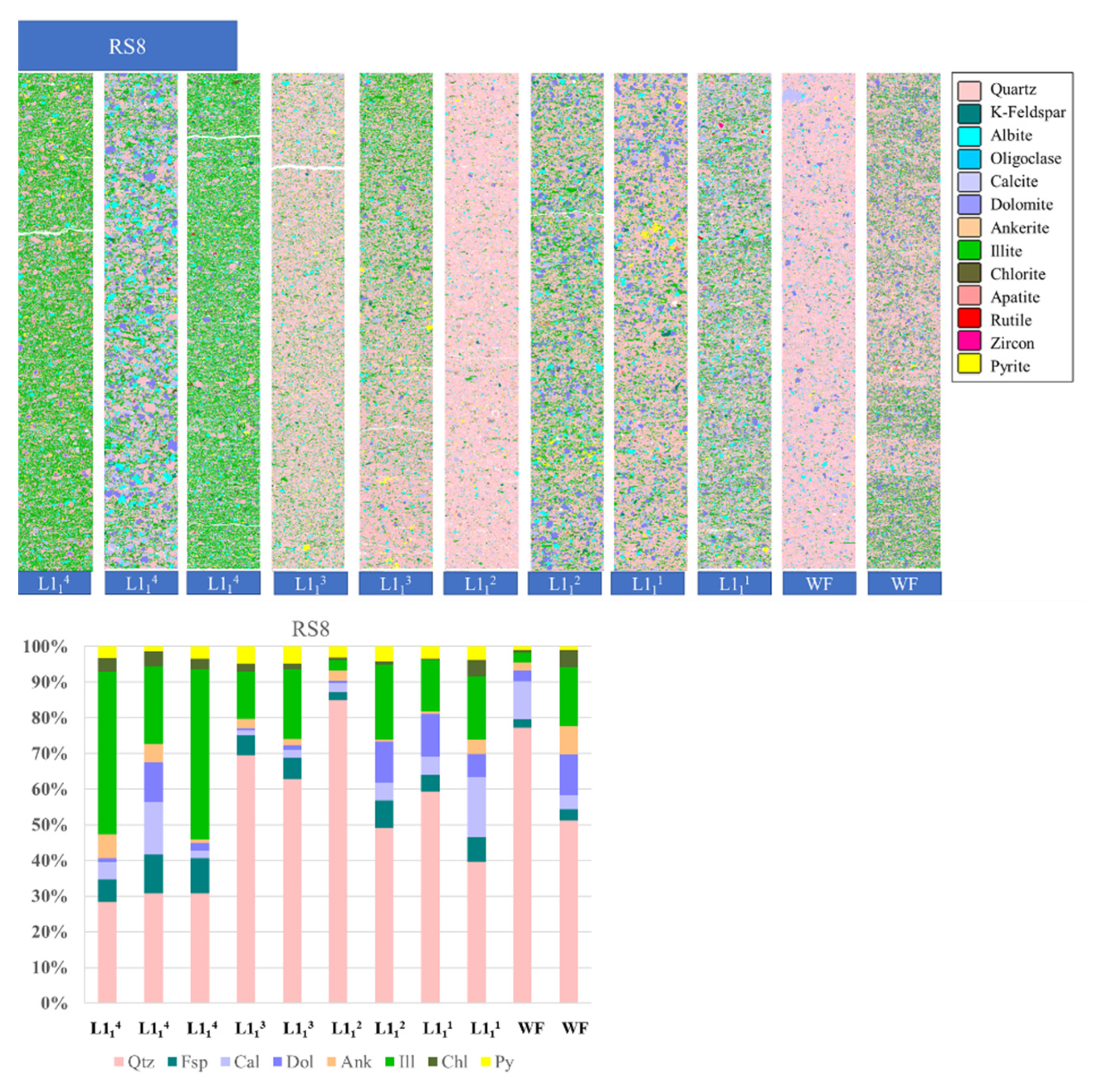


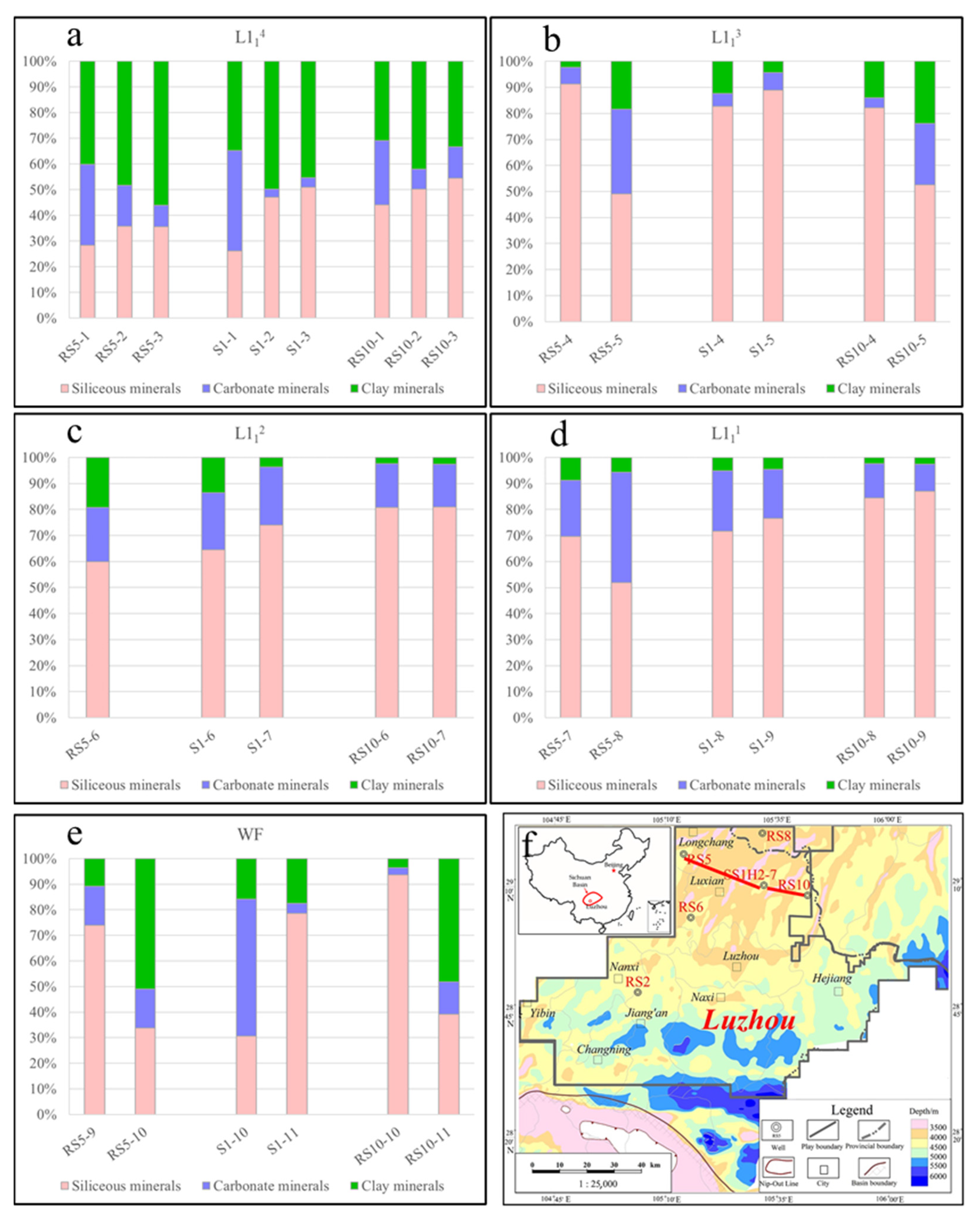
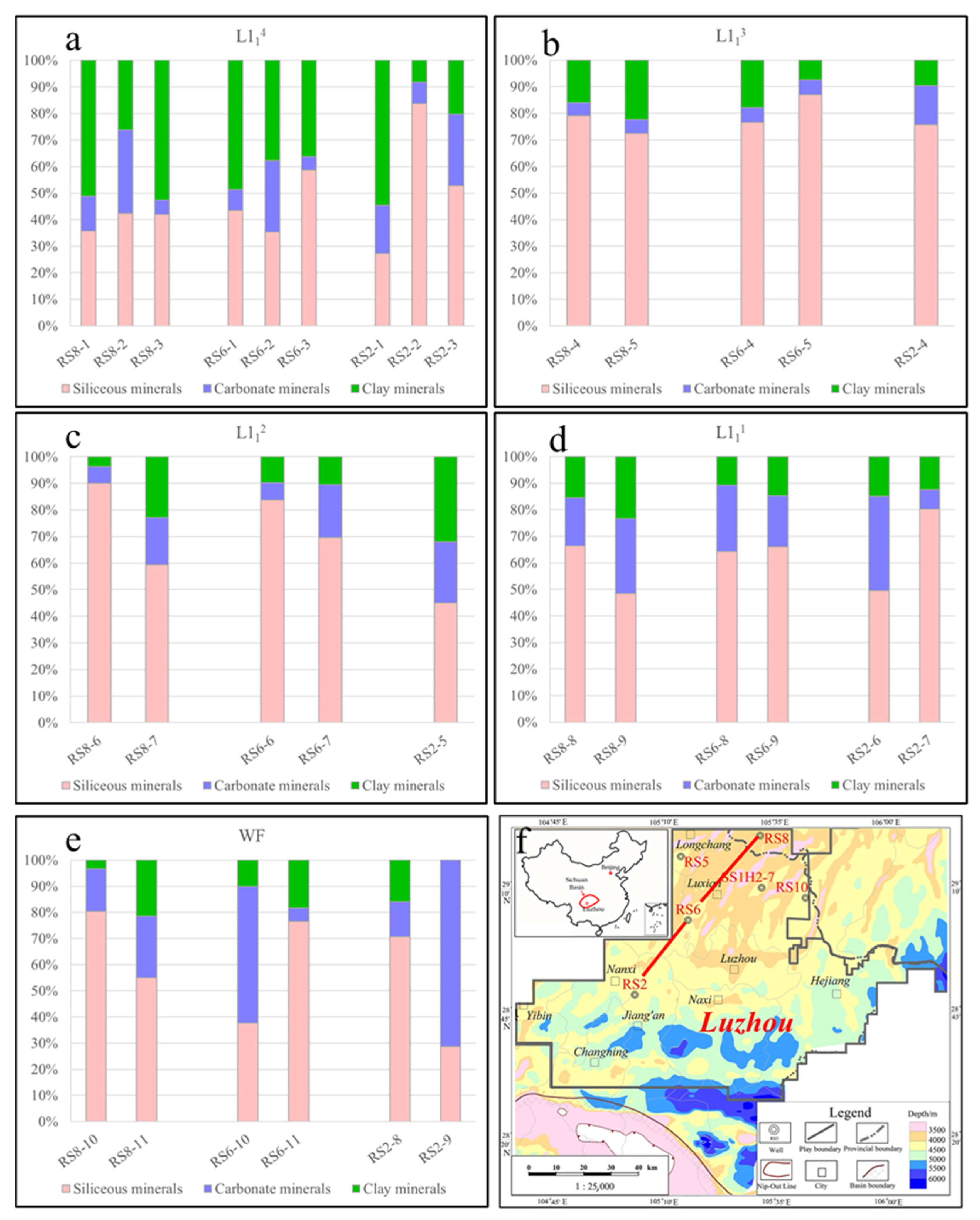
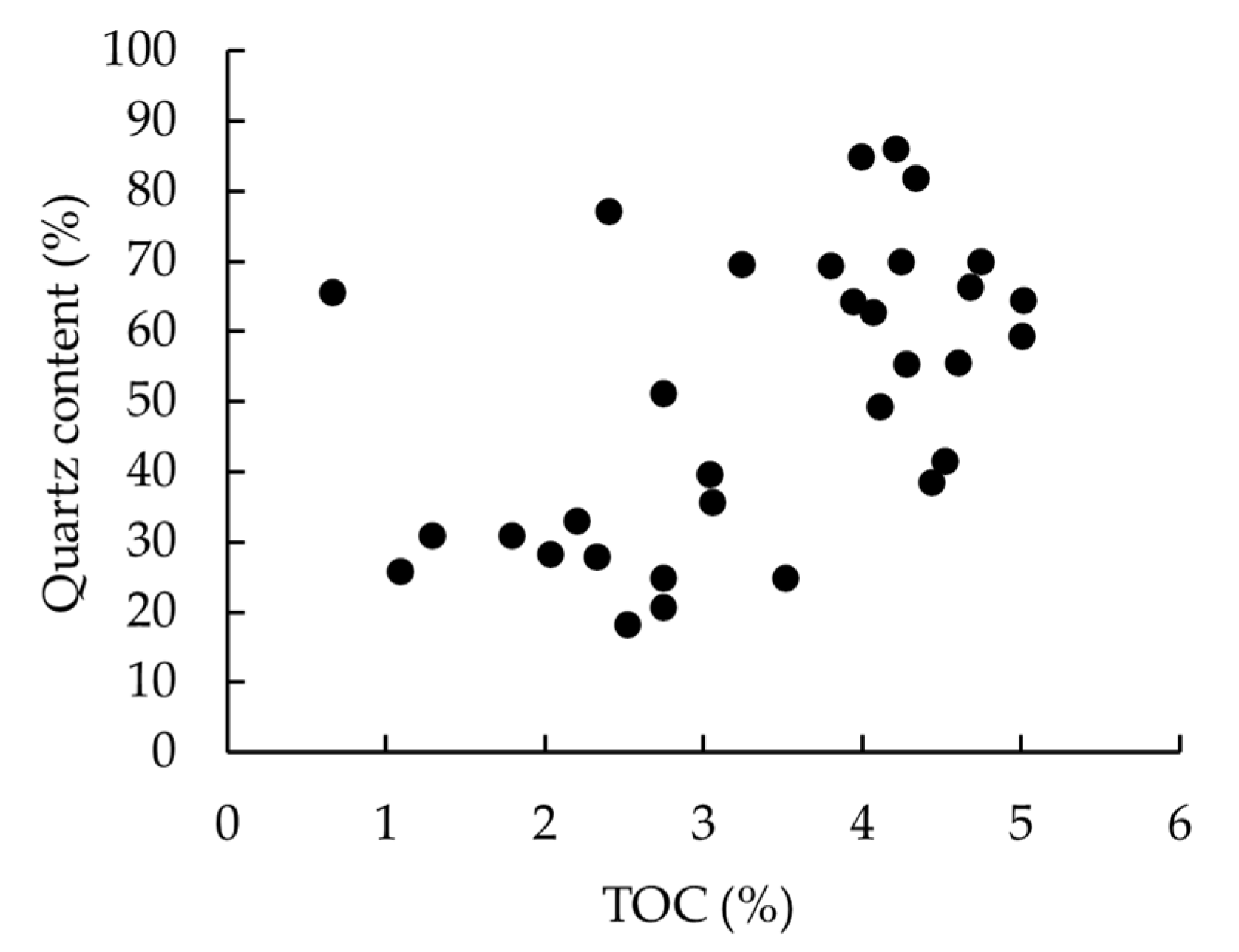

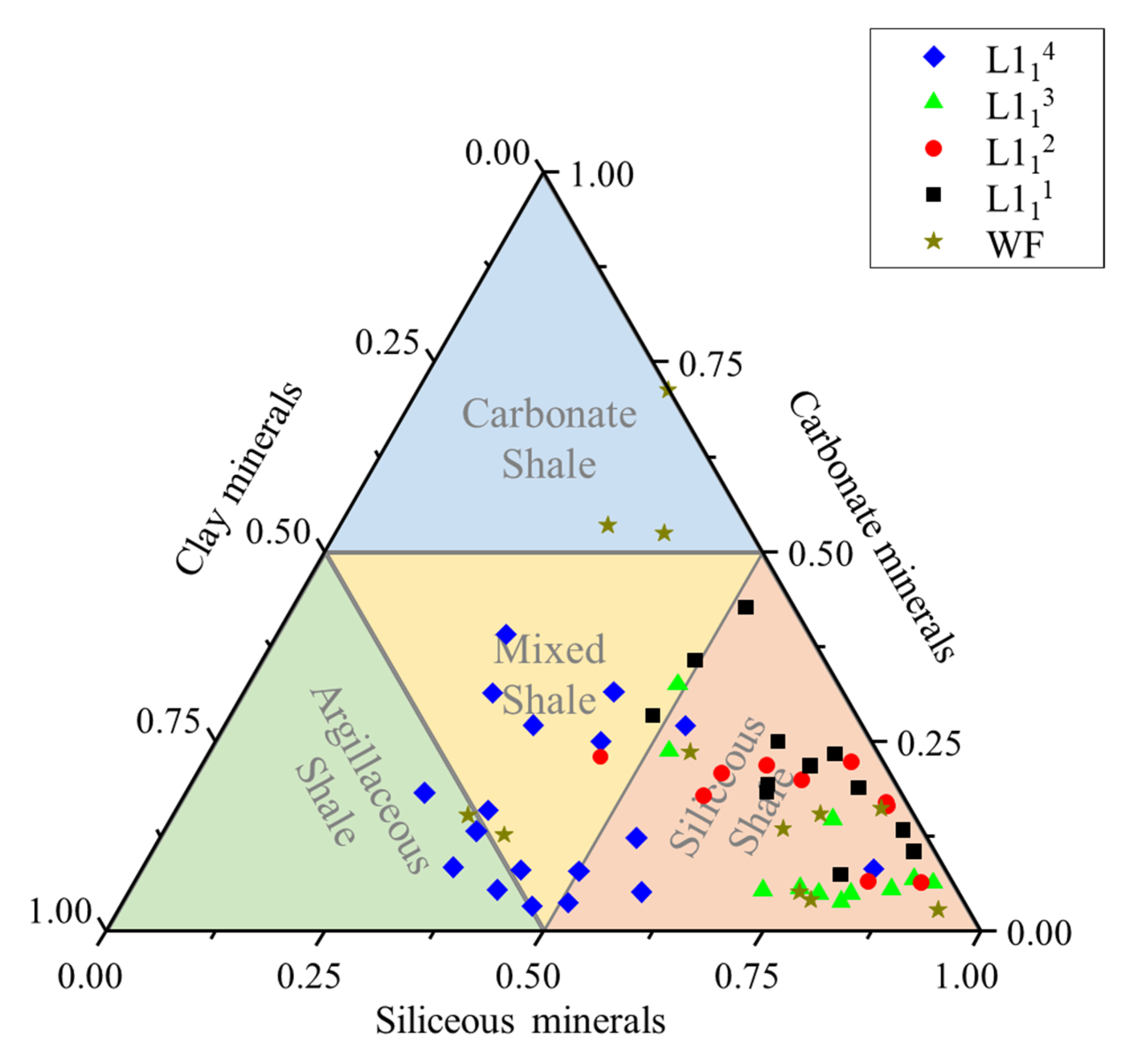
| Well | Sample ID | Depth | Sublayer | BRIT | TOC(%) | U/Th |
|---|---|---|---|---|---|---|
| RS5 | RS5-1 | 3982.99 | L114 | 57.528 | 2.745 | 0.49 |
| RS5-2 | 3994.75 | L114 | 63.938 | 2.33 | 1.04 | |
| RS5-3 | 4015.52 | L114 | 59.465 | 2.745 | 0.62 | |
| RS5-4 | 4025.28 | L113 | 69.095 | 4.213 | 1.22 | |
| RS5-5 | 4027.35 | L113 | 74.794 | 4.441 | 1.45 | |
| RS5-6 | 4029.17 | L112 | 82.051 | 4.282 | 1.34 | |
| RS5-7 | 4031.74 | L111 | 74.302 | 5.019 | 1.90 | |
| RS5-8 | 4032.2 | L111 | 68.697 | 4.525 | 2.36 | |
| RS5-9 | 4033.64 | WF | 70.848 | 3.944 | 0.70 | |
| RS5-10 | 4040.88 | WF | 70.451 | 1.088 | 0.10 | |
| SS1H2-7 | S1-1 | 4105.64 | L114 | 32.513 | 2.525 | 0.86 |
| S1-2 | 4109.49 | L114 | 35.897 | 2.201 | 1.17 | |
| S1-3 | 4113.67 | L114 | 53.474 | 3.061 | 0.79 | |
| S1-4 | 4141.59 | L113 | 51.945 | 3.802 | 1.30 | |
| S1-5 | 4144.35 | L113 | 59.062 | 4.337 | 1.27 | |
| S1-6 | 4146.42 | L112 | 66.48 | 4.608 | 1.34 | |
| S1-7 | 4149.27 | L112 | 69.446 | 4.75 | 1.72 | |
| S1-8 | 4151.25 | L111 | 51.771 | 4.679 | 3.22 | |
| S1-9 | 4151.64 | L111 | 56.961 | 4.242 | 2.44 | |
| S1-10 | 4152.45 | WF | 59.787 | 3.519 | 0.69 | |
| S1-11 | 4154.77 | WF | 55.269 | 0.667 | 0.47 | |
| RS8 | RS8-1 | 3792.3 | L114 | 56.005 | 2.034 | 0.44 |
| RS8-2 | 3796.23 | L114 | 63.395 | 1.291 | 0.13 | |
| RS8-3 | 3800.85 | L114 | 54.691 | 1.794 | 0.58 | |
| RS8-4 | 3835.18 | L113 | 59.794 | 3.244 | 0.84 | |
| RS8-5 | 3836.96 | L113 | 70.451 | 4.073 | 1.69 | |
| RS8-6 | 3839.13 | L112 | 64.871 | 3.991 | 1.94 | |
| RS8-7 | 3838.37 | L112 | 74.662 | 4.112 | 1.37 | |
| RS8-8 | 3840.1 | L111 | 70.314 | 5.011 | 2.55 | |
| RS8-9 | 3841.13 | L111 | 74.67 | 3.037 | 1.71 | |
| RS8-10 | 3843.27 | WF | 83.394 | 2.403 | 0.19 | |
| RS8-11 | 3847.28 | WF | 79.21 | 2.749 | 0.21 |
| Well | Sample ID | Depth (m) | Sublayer | Qtz (%) | Fsp (%) | Cal (%) | Dol (%) | Ank (%) | Ill (%) | Chl (%) | Py (%) | Siliceous Minerals (%) | Carbonate Minerals (%) | Clay Minerals (%) |
|---|---|---|---|---|---|---|---|---|---|---|---|---|---|---|
| RS5 | RS5-1 | 3982.99 | L114 | 20.70 | 5.00 | 10.59 | 9.13 | 8.60 | 36.00 | 0.30 | 9.67 | 28.46 | 31.35 | 40.19 |
| RS5-2 | 3994.75 | L114 | 27.89 | 7.02 | 5.69 | 4.06 | 5.75 | 44.47 | 2.70 | 2.41 | 35.77 | 15.89 | 48.34 | |
| RS5-3 | 4015.52 | L114 | 24.80 | 9.34 | 3.15 | 2.46 | 2.37 | 51.60 | 2.22 | 4.07 | 35.58 | 8.32 | 56.10 | |
| RS5-4 | 4025.28 | L113 | 86.10 | 2.99 | 3.05 | 1.94 | 1.14 | 2.02 | 0.31 | 2.45 | 91.33 | 6.28 | 2.39 | |
| RS5-5 | 4027.35 | L113 | 38.50 | 4.00 | 11.45 | 12.86 | 3.74 | 15.62 | 0.33 | 13.49 | 49.12 | 32.43 | 18.44 | |
| RS5-6 | 4029.17 | L112 | 55.30 | 3.90 | 7.95 | 12.46 | 0.00 | 18.91 | 0.08 | 1.41 | 60.05 | 20.70 | 19.26 | |
| RS5-7 | 4031.74 | L111 | 64.37 | 3.49 | 6.56 | 13.61 | 1.01 | 8.29 | 0.19 | 2.48 | 69.58 | 21.72 | 8.70 | |
| RS5-8 | 4032.20 | L111 | 41.47 | 8.77 | 9.94 | 15.09 | 16.21 | 5.08 | 0.33 | 3.11 | 51.86 | 42.56 | 5.58 | |
| RS5-9 | 4033.64 | WF | 64.23 | 7.53 | 12.44 | 1.37 | 1.08 | 9.84 | 0.57 | 2.94 | 73.93 | 15.35 | 10.72 | |
| RS5-10 | 4040.88 | WF | 25.78 | 7.91 | 7.64 | 0.37 | 7.18 | 46.87 | 4.01 | 0.24 | 33.78 | 15.22 | 51.00 | |
| SS1H2-7 | S1-1 | 4105.64 | L114 | 18.26 | 7.48 | 14.60 | 10.09 | 13.58 | 27.57 | 6.47 | 1.95 | 26.25 | 39.04 | 34.72 |
| S1-2 | 4109.49 | L114 | 32.93 | 12.87 | 1.94 | 0.64 | 0.57 | 42.63 | 5.74 | 2.69 | 47.07 | 3.23 | 49.70 | |
| S1-3 | 4113.67 | L114 | 35.60 | 12.89 | 2.02 | 0.62 | 0.87 | 38.69 | 4.50 | 4.82 | 50.94 | 3.68 | 45.38 | |
| S1-4 | 4141.59 | L113 | 69.37 | 8.97 | 1.71 | 1.06 | 1.82 | 9.02 | 2.75 | 5.29 | 82.72 | 4.85 | 12.43 | |
| S1-5 | 4144.35 | L113 | 81.83 | 4.93 | 2.59 | 2.27 | 1.80 | 3.09 | 1.14 | 2.34 | 88.85 | 6.82 | 4.34 | |
| S1-6 | 4146.42 | L112 | 55.49 | 6.30 | 9.83 | 6.91 | 4.17 | 9.40 | 3.58 | 4.32 | 64.57 | 21.85 | 13.57 | |
| S1-7 | 4149.27 | L112 | 69.91 | 2.55 | 9.16 | 6.64 | 5.90 | 1.99 | 1.67 | 2.19 | 74.08 | 22.18 | 3.74 | |
| S1-8 | 4151.25 | L111 | 66.39 | 3.89 | 6.36 | 10.43 | 6.06 | 2.79 | 2.22 | 1.86 | 71.62 | 23.28 | 5.10 | |
| S1-9 | 4151.64 | L111 | 69.98 | 3.32 | 12.07 | 2.91 | 3.02 | 2.87 | 1.54 | 4.29 | 76.58 | 18.81 | 4.61 | |
| S1-10 | 4152.45 | WF | 24.90 | 4.78 | 33.22 | 15.28 | 3.34 | 10.59 | 4.84 | 3.06 | 30.61 | 53.48 | 15.91 | |
| S1-11 | 4154.77 | WF | 65.63 | 12.16 | 0.98 | 2.03 | 0.96 | 13.79 | 3.49 | 0.95 | 78.54 | 4.01 | 17.45 | |
| RS10 | RS10-1 | 4232.89 | L114 | 30.36 | 11.93 | 14.97 | 0.00 | 8.92 | 21.80 | 7.91 | 4.12 | 44.10 | 24.92 | 30.98 |
| RS10-2 | 4244.89 | L114 | 37.11 | 11.55 | 5.05 | 0.02 | 2.48 | 34.48 | 6.30 | 3.01 | 50.17 | 7.79 | 42.04 | |
| RS10-3 | 4260.49 | L114 | 37.28 | 14.85 | 4.87 | 0.01 | 6.83 | 24.49 | 7.30 | 4.36 | 54.50 | 12.25 | 33.25 | |
| RS10-4 | 4272.53 | L113 | 67.86 | 9.47 | 1.83 | 0.72 | 1.08 | 10.82 | 2.44 | 5.80 | 82.09 | 3.85 | 14.07 | |
| RS10-5 | 4276.4 | L113 | 40.05 | 7.65 | 9.00 | 9.99 | 2.50 | 17.88 | 3.75 | 9.17 | 52.52 | 23.66 | 23.82 | |
| RS10-6 | 4277.35 | L112 | 77.58 | 2.37 | 6.03 | 6.58 | 4.14 | 1.49 | 0.84 | 0.97 | 80.73 | 16.91 | 2.35 | |
| RS10-7 | 4278.84 | L112 | 77.56 | 2.63 | 9.19 | 4.20 | 2.89 | 1.57 | 0.89 | 1.06 | 81.06 | 16.46 | 2.49 | |
| RS10-8 | 4280.94 | L111 | 80.44 | 3.20 | 8.54 | 1.88 | 2.63 | 1.54 | 0.79 | 0.98 | 84.47 | 13.18 | 2.35 | |
| RS10-9 | 4281.46 | L111 | 83.14 | 3.23 | 6.82 | 1.54 | 1.95 | 1.74 | 0.73 | 0.85 | 87.11 | 10.40 | 2.49 | |
| RS10-10 | 4282.92 | WF | 87.21 | 4.56 | 0.69 | 0.74 | 1.30 | 2.51 | 0.94 | 2.05 | 93.70 | 2.78 | 3.52 | |
| RS10-11 | 4284.98 | WF | 29.02 | 10.02 | 7.97 | 1.21 | 3.39 | 38.00 | 10.03 | 0.37 | 39.18 | 12.62 | 48.21 | |
| RS2 | RS2-1 | 4245.04 | L114 | 18.66 | 8.10 | 12.86 | 3.04 | 1.90 | 51.56 | 1.87 | 2.01 | 27.32 | 18.16 | 54.53 |
| RS2-2 | 4273.44 | L114 | 31.40 | 49.15 | 5.01 | 2.87 | 0.00 | 4.85 | 3.02 | 3.70 | 83.65 | 8.18 | 8.16 | |
| RS2-3 | 4285.04 | L114 | 16.90 | 34.91 | 1.04 | 4.70 | 20.85 | 17.77 | 2.10 | 1.73 | 52.72 | 27.05 | 20.23 | |
| RS2-4 | 4312.09 | L113 | 62.75 | 10.69 | 4.69 | 5.24 | 4.42 | 9.14 | 0.18 | 2.90 | 75.63 | 14.77 | 9.59 | |
| RS2-5 | 4317.16 | L112 | 37.22 | 5.47 | 9.07 | 5.25 | 7.37 | 30.20 | 0.14 | 5.29 | 45.07 | 22.89 | 32.04 | |
| RS2-6 | 4318.92 | L111 | 44.53 | 4.01 | 12.54 | 21.15 | 1.18 | 14.47 | 0.12 | 2.00 | 49.53 | 35.58 | 14.89 | |
| RS2-7 | 4322.26 | L111 | 74.10 | 4.75 | 3.64 | 2.67 | 0.98 | 11.87 | 0.24 | 1.75 | 80.25 | 7.42 | 12.33 | |
| RS2-8 | 4325.94 | WF | 65.66 | 4.06 | 6.12 | 2.33 | 4.73 | 15.35 | 0.38 | 1.37 | 70.69 | 13.36 | 15.95 | |
| RS2-9 | 4328.55 | WF | 24.53 | 3.72 | 43.79 | 26.59 | 0.00 | 0.01 | 0.09 | 1.26 | 28.61 | 71.29 | 0.10 | |
| RS6 | RS6-1 | 3983.90 | L114 | 31.83 | 9.88 | 3.92 | 2.57 | 1.21 | 43.21 | 3.46 | 3.91 | 43.41 | 8.02 | 48.57 |
| RS6-2 | 3987.57 | L114 | 26.95 | 7.25 | 4.23 | 6.72 | 15.32 | 28.48 | 7.97 | 3.07 | 35.29 | 27.10 | 37.61 | |
| RS6-3 | 4008.06 | L114 | 41.95 | 14.69 | 1.87 | 0.82 | 2.22 | 29.05 | 5.97 | 3.42 | 58.65 | 5.09 | 36.26 | |
| RS6-4 | 4027.42 | L113 | 63.37 | 8.85 | 1.19 | 2.73 | 1.34 | 14.48 | 2.44 | 5.60 | 76.50 | 5.57 | 17.93 | |
| RS6-5 | 4031.49 | L113 | 77.66 | 5.75 | 1.25 | 2.75 | 1.24 | 6.17 | 1.02 | 4.16 | 87.03 | 5.46 | 7.51 | |
| RS6-6 | 4033.08 | L112 | 74.31 | 5.88 | 1.95 | 2.77 | 1.45 | 8.31 | 1.04 | 4.28 | 83.77 | 6.46 | 9.77 | |
| RS6-7 | 4037.69 | L112 | 61.57 | 5.04 | 7.99 | 7.54 | 3.43 | 8.49 | 1.63 | 4.32 | 69.61 | 19.81 | 10.57 | |
| RS6-8 | 4039.42 | L111 | 56.07 | 6.36 | 13.88 | 8.45 | 1.85 | 9.22 | 1.23 | 2.95 | 64.32 | 24.91 | 10.78 | |
| RS6-9 | 4039.94 | L111 | 55.49 | 8.14 | 9.64 | 7.11 | 1.82 | 12.40 | 1.82 | 3.58 | 65.99 | 19.26 | 14.75 | |
| RS6-10 | 4041.15 | WF | 30.69 | 6.04 | 33.41 | 14.25 | 3.52 | 8.54 | 1.26 | 2.30 | 37.60 | 52.37 | 10.03 | |
| RS6-11 | 4047.45 | WF | 67.40 | 8.42 | 1.40 | 2.35 | 1.32 | 14.58 | 3.44 | 1.10 | 76.66 | 5.12 | 18.22 | |
| RS8 | RS8-1 | 3792.30 | L114 | 28.24 | 6.34 | 4.82 | 1.24 | 6.61 | 45.68 | 3.73 | 3.34 | 35.77 | 13.12 | 51.11 |
| RS8-2 | 3796.23 | L114 | 30.85 | 10.85 | 14.69 | 11.09 | 5.17 | 21.69 | 4.15 | 1.50 | 42.34 | 31.43 | 26.24 | |
| RS8-3 | 3800.85 | L114 | 30.86 | 9.70 | 2.00 | 2.19 | 1.02 | 47.84 | 2.89 | 3.50 | 42.03 | 5.40 | 52.57 | |
| RS8-4 | 3835.18 | L113 | 69.49 | 5.58 | 1.40 | 0.55 | 2.64 | 13.26 | 2.07 | 5.01 | 79.03 | 4.83 | 16.14 | |
| RS8-5 | 3836.96 | L113 | 62.80 | 6.12 | 2.02 | 1.36 | 1.71 | 19.60 | 1.62 | 4.76 | 72.36 | 5.35 | 22.29 | |
| RS8-6 | 3838.37 | L112 | 84.89 | 2.29 | 2.53 | 0.65 | 2.91 | 2.75 | 0.88 | 3.10 | 89.97 | 6.28 | 3.75 | |
| RS8-7 | 3839.13 | L112 | 49.20 | 7.66 | 5.02 | 11.48 | 0.52 | 20.98 | 0.85 | 4.29 | 59.41 | 17.79 | 22.80 | |
| RS8-8 | 3840.10 | L111 | 59.27 | 4.80 | 4.92 | 12.08 | 0.61 | 14.58 | 0.28 | 3.46 | 66.37 | 18.24 | 15.39 | |
| RS8-9 | 3841.13 | L111 | 39.68 | 6.83 | 16.90 | 6.35 | 4.02 | 17.75 | 4.68 | 3.79 | 48.34 | 28.35 | 23.31 | |
| RS8-10 | 3843.27 | WF | 77.12 | 2.46 | 10.70 | 2.89 | 2.34 | 2.65 | 0.70 | 1.15 | 80.49 | 16.11 | 3.39 | |
| RS8-11 | 3847.28 | WF | 51.16 | 3.19 | 3.97 | 11.36 | 8.01 | 16.60 | 4.66 | 1.05 | 54.93 | 23.59 | 21.49 | |
| AVG | - | - | - | 51.33 | 7.91 | 7.88 | 5.59 | 3.79 | 17.76 | 2.49 | 3.24 | 62.49 | 17.26 | 20.25 |
| Variables | rs | p-Value |
|---|---|---|
| TOC—quartz content of RS8, RS5 and SS1H2-7 | 0.51 | 0.002 |
| BRIT—∑Si + Ca * of RS8, RS5 and SS1H2-7 | 0.24 | 0.183 |
| BRIT—∑Si + Ca of RS8, and RS5 | 0.43 | 0.049 |
| BRIT—∑Si + Ca of SS1H2-7 | 0.58 | 0.050 |
| BRIT—∑Si + Ca of RS8 | 0.50 | 0.117 |
| BRIT—∑Si + Ca of RS5 | 0.33 | 0.346 |
Publisher’s Note: MDPI stays neutral with regard to jurisdictional claims in published maps and institutional affiliations. |
© 2021 by the authors. Licensee MDPI, Basel, Switzerland. This article is an open access article distributed under the terms and conditions of the Creative Commons Attribution (CC BY) license (https://creativecommons.org/licenses/by/4.0/).
Share and Cite
Yang, H.; Shi, X.; Luo, C.; Wu, W.; Li, Y.; He, Y.; Zhong, K.; Wu, J. Mineral Composition of Prospective Section of Wufeng-Longmaxi Shale in Luzhou Shale Play, Sichuan Basin. Minerals 2022, 12, 20. https://doi.org/10.3390/min12010020
Yang H, Shi X, Luo C, Wu W, Li Y, He Y, Zhong K, Wu J. Mineral Composition of Prospective Section of Wufeng-Longmaxi Shale in Luzhou Shale Play, Sichuan Basin. Minerals. 2022; 12(1):20. https://doi.org/10.3390/min12010020
Chicago/Turabian StyleYang, Hongzhi, Xuewen Shi, Chao Luo, Wei Wu, Yi Li, Yifan He, Kesu Zhong, and Jianguo Wu. 2022. "Mineral Composition of Prospective Section of Wufeng-Longmaxi Shale in Luzhou Shale Play, Sichuan Basin" Minerals 12, no. 1: 20. https://doi.org/10.3390/min12010020
APA StyleYang, H., Shi, X., Luo, C., Wu, W., Li, Y., He, Y., Zhong, K., & Wu, J. (2022). Mineral Composition of Prospective Section of Wufeng-Longmaxi Shale in Luzhou Shale Play, Sichuan Basin. Minerals, 12(1), 20. https://doi.org/10.3390/min12010020





